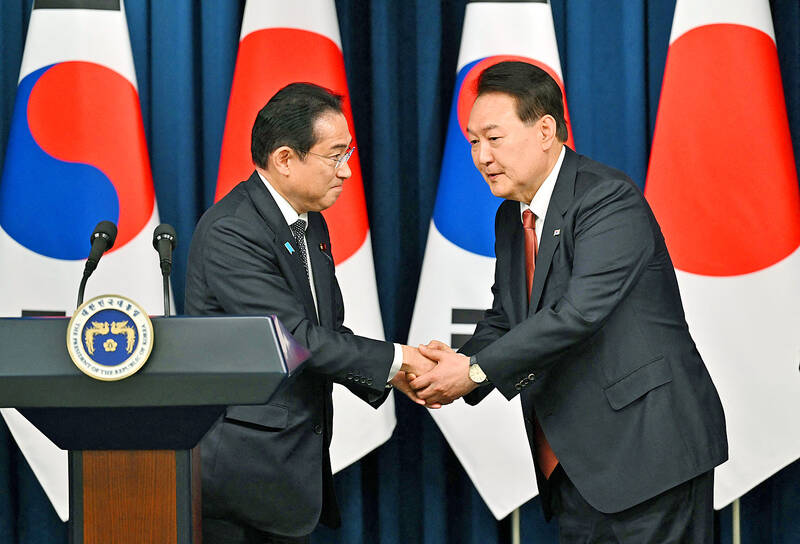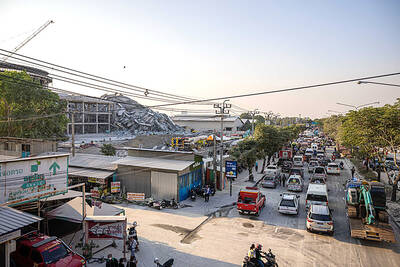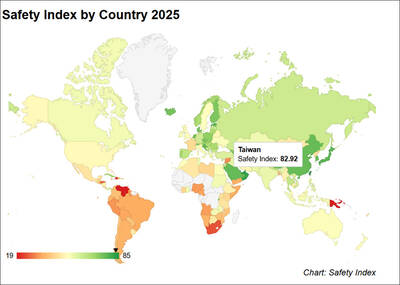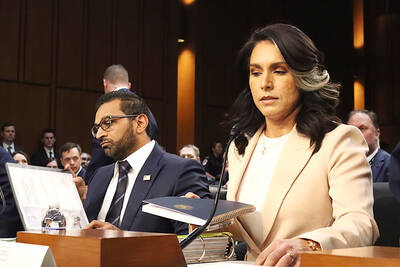Japanese Prime Minister Fumio Kishida yesterday said his “heart aches” for Koreans who suffered under colonialism, as Seoul and Tokyo seek a rapid reset of long-strained ties in the face of North Korean threats.
Kishida was in Seoul on the first official bilateral visit by a Japanese leader to South Korea in more than a decade. He met South Korean President Yoon Suk-yeol, who has made improving testy relations with Japan a top priority for his administration.
The East Asian neighbors, both crucial security allies of the US, have long been at odds over historic issues linked to Japan’s brutal 1910 to 1945 colonial occupation of the Korean Peninsula, including sexual slavery and forced labor.

Photo: AFP
“My heart aches as many people went through a very difficult and sad experience in the harsh environment at that time,” Kishida said, speaking after the summit with Yoon.
Kishida’s visit showed that “shuttle diplomacy” — regular mutual visits and high-level talks — was back on track, Yoon said, after a lengthy pause during a bitter trade spat linked to the forced labor issue.
“Based on the friendship and trust I have with Prime Minister Kishida, I will promote deeper bilateral cooperation toward a new future,” said Yoon, who was in Tokyo in March for a fence-mending visit.
Yoon, who took office last year, has sought to bury the historical hatchet.
He earlier announced a plan to compensate victims without direct involvement from Tokyo — a move that was unpopular domestically, but helped improve ties with Japan.
“As the South Korean government moves forward ... I am touched to see how so many people are opening their hearts to the future while not forgetting the hardships of the past,” Kishida said.
Experts had widely predicted Tokyo would not offer a new apology, and Kishida stopped short of this, instead reaffirming the “heartfelt apology” made by previous administrations in Tokyo.
“There are parts of Kishida’s statement that definitely fall short of our expectations,” Choi Eunmi, a researcher at the Asan Institute for Policy Studies, told YTN.
“But even though he said it was his personal feeling, I would like to note his expression of sincerity,” she said. “And I think this is meaningful as we are just taking our first step in restoring shuttle diplomacy.”
Efforts to mend ties come as North Korean leader Kim Jong-un, who last year declared his country an “irreversible” nuclear power, doubles down on weapons development and testing.
“Prime Minister Kishida and I shared the recognition that North Korea’s nuclear and missile development poses a grave threat to peace and stability not only on the Korean Peninsula and Japan, but also throughout the world,” Yoon said.
The leaders agreed to hold a trilateral meeting with the US on the sidelines of the upcoming G7 summit in Hiroshima.
US President Joe Biden’s administration has been seeking help from its partners to impose sweeping curbs on the sale of advanced chips equipment to China in a policy aimed at preventing the country’s progression in a range of cutting-edge technologies.
Yoon and Kishida yesterday agreed to cooperate on chips, without elaborating on what the partnership would entail.
Additional reporting by Bloomberg

AIR SUPPORT: The Ministry of National Defense thanked the US for the delivery, adding that it was an indicator of the White House’s commitment to the Taiwan Relations Act Deputy Minister of National Defense Po Horng-huei (柏鴻輝) and Representative to the US Alexander Yui on Friday attended a delivery ceremony for the first of Taiwan’s long-awaited 66 F-16C/D Block 70 jets at a Lockheed Martin Corp factory in Greenville, South Carolina. “We are so proud to be the global home of the F-16 and to support Taiwan’s air defense capabilities,” US Representative William Timmons wrote on X, alongside a photograph of Taiwanese and US officials at the event. The F-16C/D Block 70 jets Taiwan ordered have the same capabilities as aircraft that had been upgraded to F-16Vs. The batch of Lockheed Martin

GRIDLOCK: The National Fire Agency’s Special Search and Rescue team is on standby to travel to the countries to help out with the rescue effort A powerful earthquake rocked Myanmar and neighboring Thailand yesterday, killing at least three people in Bangkok and burying dozens when a high-rise building under construction collapsed. Footage shared on social media from Myanmar’s second-largest city showed widespread destruction, raising fears that many were trapped under the rubble or killed. The magnitude 7.7 earthquake, with an epicenter near Mandalay in Myanmar, struck at midday and was followed by a strong magnitude 6.4 aftershock. The extent of death, injury and destruction — especially in Myanmar, which is embroiled in a civil war and where information is tightly controlled at the best of times —

Taiwan was ranked the fourth-safest country in the world with a score of 82.9, trailing only Andorra, the United Arab Emirates and Qatar in Numbeo’s Safety Index by Country report. Taiwan’s score improved by 0.1 points compared with last year’s mid-year report, which had Taiwan fourth with a score of 82.8. However, both scores were lower than in last year’s first review, when Taiwan scored 83.3, and are a long way from when Taiwan was named the second-safest country in the world in 2021, scoring 84.8. Taiwan ranked higher than Singapore in ninth with a score of 77.4 and Japan in 10th with

SECURITY RISK: If there is a conflict between China and Taiwan, ‘there would likely be significant consequences to global economic and security interests,’ it said China remains the top military and cyber threat to the US and continues to make progress on capabilities to seize Taiwan, a report by US intelligence agencies said on Tuesday. The report provides an overview of the “collective insights” of top US intelligence agencies about the security threats to the US posed by foreign nations and criminal organizations. In its Annual Threat Assessment, the agencies divided threats facing the US into two broad categories, “nonstate transnational criminals and terrorists” and “major state actors,” with China, Russia, Iran and North Korea named. Of those countries, “China presents the most comprehensive and robust military threat